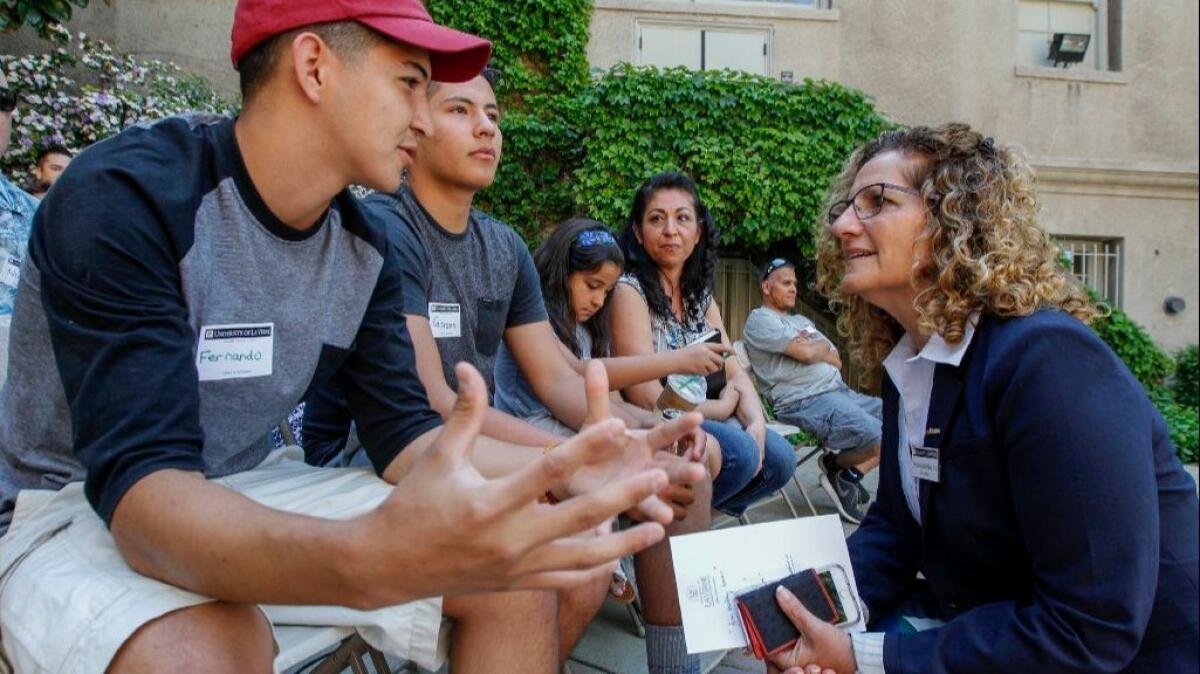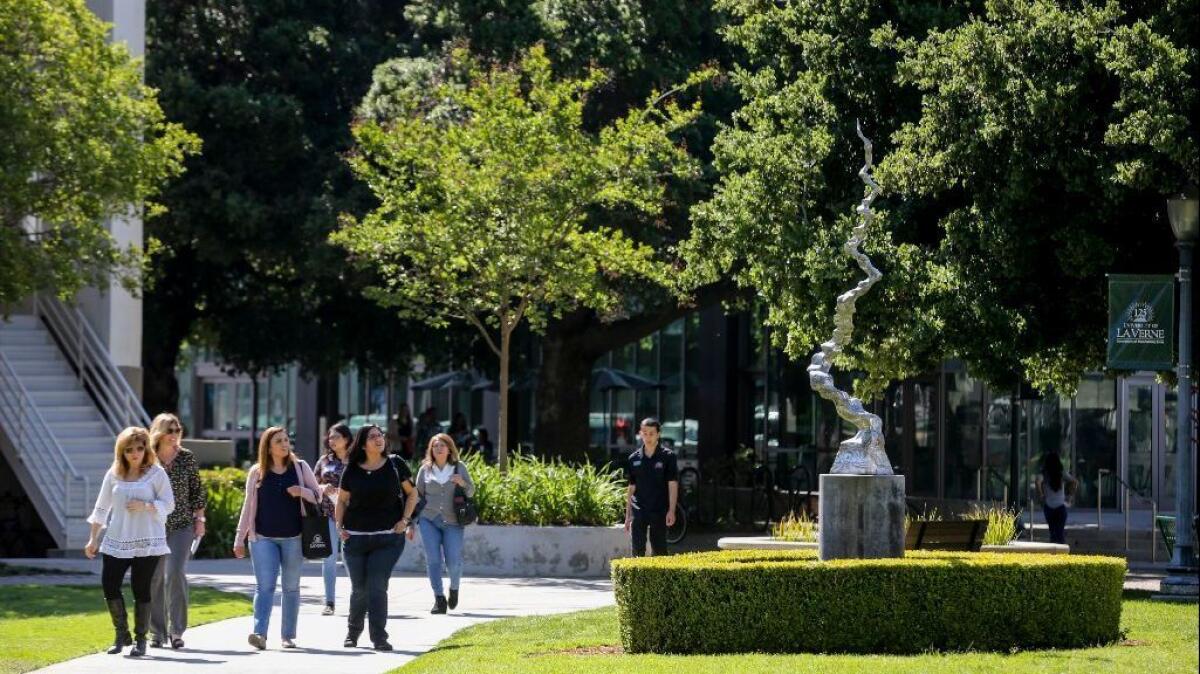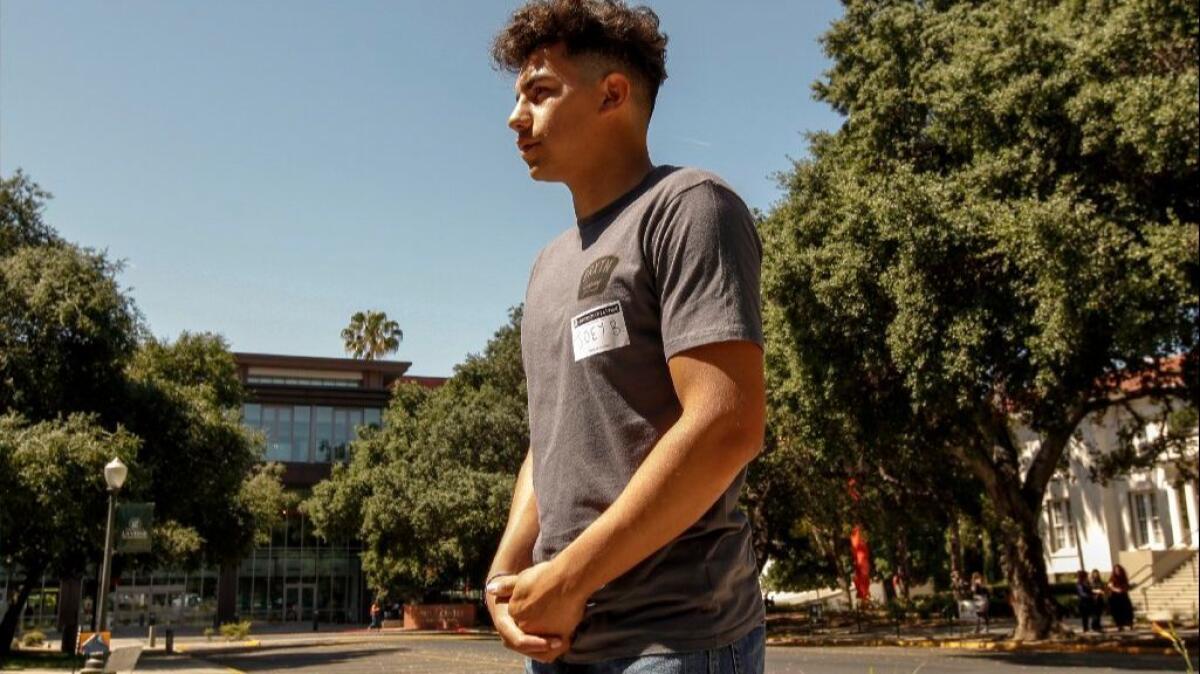These small, little-known colleges may be more affordable than you think

At the University of La Verne, students are surprised to find a private school with a public mission.
When Ryan Gray considered his college options, the one that made the most financial sense surprised him.
It wasn’t Cal State Long Beach or Cal Poly Pomona, two of California’s most affordable universities. It wasn’t UC Irvine or UC Riverside, also public schools with in-state tuition. Breaking down each acceptance package and financial aid offer, Gray realized his best choice was the University of La Verne, a private school with a sticker price of more than $40,000 a year but an out-of-pocket cost closer to $6,000.
“It surprised my parents a lot,” said Gray, whose father didn’t finish community college, and whose mother completed her bachelor’s at Cal State Northridge while raising two kids. “I’m paying $3,000 a semester this year.… That’s basically the price of a Cal State, maybe less.”
As enrollment continues to outpace capacity at public universities and the nation grapples with rising student debt and how to ensure equitable access to college, educators point to small, little-known private schools like La Verne, Whittier College and the University of Redlands that have found ways to make their offerings affordable and to support their surrounding communities while keeping pace with the state’s changing demographics.
At La Verne, 96% of its undergraduates receive grants from the school. Nearly half (49%) qualify for Pell Grants, federal financial aid for low-income students. The school spends more than a quarter of its operating budget — about $47 million each year — on student financial support, finding savings elsewhere to do so.
About 40% of its young men and women are the first in their families to attend college, and almost half are Latino. Most of its 2,800 undergraduates come from within 50 miles of campus. Many save money by living at home. About 48% of those who apply are accepted.
La Verne officials were among the many educators upset when Gov. Jerry Brown’s budget proposal cut the amount of state aid available to low-income students attending private colleges — a change the Democrat dropped after months of lobbying.
“There is still a perception that private colleges are only for the wealthy, and it could not be further from the truth,” said Kristen Soares, president of the Assn. of Independent California Colleges and Universities. “For La Verne to be able to provide that assurance goes so far within a community.… Their mission, their graduation rate, the commitments they make to institutional aid speak for themselves.”
Half the battle for these private schools is getting the word out. La Verne actively recruits from community colleges and was one of the first privates in the state to work with dozens of local high schools to create a pathway program for those who make the grade: guaranteed admission and at least $10,000 in financial aid each year, along with application fee waivers, advising and college prep courses.
Once recruiters have a student’s attention, they say, the pitch is easy: Small class sizes, advisors who will stick with you, professors who will know your name and access to the classes you need. Many potential students hear from siblings and friends at Cal State, where classes are packed and required courses fill up, meaning they can’t graduate on time. Right now, only one in five students graduate from Cal State in four years.
Gray, now a senior, expects to graduate with honors in December, a semester early — saving more money. With the help of an advisor, he maximized his schedule and his small-school experience, taking an international marketing class in Cuba, joining student government and a fraternity, bumping into the same classmates and professors and deans every day until they all felt like family.
“Because it’s a private university, it looks intimidating at first,” he said one recent morning outside the campus center. “You think you don’t belong; you think you can’t afford it.” He paused to wave to the dean of student affairs, who was running by on the way to a meeting, then made a sweeping gesture at all the students walking across campus. “But here? You do. You can.”

Founded in 1891 by the Church of the Brethren, a German pacifist group similar to Quakers and Mennonites, the University of La Verne is a big part of the humble Pomona Valley suburb that shares its name. Visitors getting off the train at the future Foothill Gold Line stop, officials like to say, will have to walk through campus to get to downtown.
Many local educators and civic leaders are alumni, including La Verne’s police chief and the chiefs in Covina, Glendora and Los Alamitos. Many of the state’s school superintendents graduated from La Verne’s education school.
Community service plays a major role on campus. It’s a required part of the “La Verne Experience” developed by university President Devorah Lieberman, from when students arrive until graduation.
Helping students succeed at La Verne requires much more than financial aid, Lieberman said. Administrators and faculty have to pay attention to how students fit in, get involved, pursue research.
In their first semester, freshmen are put into groups of 18, and together take a writing course and two core courses, in subjects such as math, art, economics, biology and religion. The three full-time professors who teach the courses work as a team to find ways to make connections between the subjects and to mentor the new students. The bundled courses foster friendships and a culture of interacting closely with faculty, Lieberman said. “Nobody feels left out. Nobody falls through the cracks.”
Sophomore year, all students take a career-oriented course that includes resume writing and career mapping. Signing up for a club is strongly encouraged (most students end up joining more than one). Sophomores are asked to attend at least six of the many guest lectures and events on campus.
“We make it seamless between the curriculum and co-curriculum, as opposed to, ‘These are your courses, now on your own go figure out where is health services, where is student career services and the interfaith organizations and what resources are at the library,” said Lieberman, who once hosted pajama town halls so students would feel comfy talking openly about their concerns. “At larger schools, you often have to create your own path. You have to create your own relationships. You have to figure things out much more on your own.”
Jason Fuentes, who just graduated in May with a degree in political science, loved the way the system worked. He made close friends among the 18 in his freshman group and grew confident in public speaking by joining Model UN.
“I had a philosophy class with six students. It was amazing,” he said — and even more so when he compares his experience to his sister’s as a biology major at UC Riverside. “She tells me that it’s just lecture halls,” he said. “Sometimes, they don’t even get direct contact with the professors. It’s always the teacher’s aides.”
Fuentes lived with his parents in Pomona and graduated with little debt. Financial aid brought his annual college costs down to about $1,600, he said.

Virginia Kelsen is the executive director of career readiness at the Chaffey Joint Union High School District in San Bernardino County, which was the first district La Verne worked with to create a guaranteed admissions pathway for students. Improving awareness about, and access to, regional private schools like La Verne is transformative for many working families, she said, especially those who need their children to stay close to home and might have no idea they can afford a private school.
“It makes college attendance a reality,” she said of the pathway partnership and the financial aid. “There’s tremendous power in that.”

Joey Beas of Tustin got accepted by La Verne this spring. One morning, he and his father, Armando, arrived on campus for an accepted students day. At first a little shy and unsure how to act, they marveled at the fountains, the landscaped courtyard, the mosaic tiles and ivy-covered buildings.
Beas’ father, who grew up a few blocks from campus but skipped college to take care of his family, was eager to see what the school was all about. When father and son arrived, the admissions staff greeted Joey by name, asked him about Tustin and chatted about basketball.
“It felt like they knew me already,” he said, amazed. “It set the tone right off the bat that this was a family.”
Lieberman was there to greet the students, too. She said hello to each of them and asked about their interests.
“I’d like you, in the four years that you’re at the University of La Verne, to think much bigger than a major,” she told them. “Here is your opportunity, for four years, to think about a mission. Think about what’s your purpose, what’s your place in life. Where do you want to go? What legacy do you want to leave? What impact do you want to make in your community and on the world? … Very few of us have those years where we can think about big purposes in our life. This is your opportunity to think about majoring in a mission.”
Before the crowd split up into smaller groups for student-led tours, Todd Eckel, dean of admissions, acknowledged that some might feel overwhelmed. “I know, you’re probably thinking, ‘Oh my goodness, there’s ivy on the side of the building!’ Yes, it’s been growing for 125 years. There is history here.… There is a community.… Look around, ask yourself: Can I see myself here?”
Beas laughed with his future classmates. He glanced at his father and nodded.
Follow @RosannaXia for more education news
ALSO
1 in 5 L.A. community college students is homeless, survey finds
The politics of math: Is algebra necessary to obtain a college degree?
Schools are boosting graduation rates by offering ‘credit recovery.’ But what are students learning?
More to Read
Sign up for Essential California
The most important California stories and recommendations in your inbox every morning.
You may occasionally receive promotional content from the Los Angeles Times.











